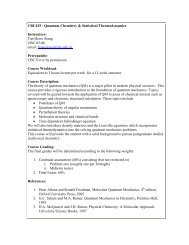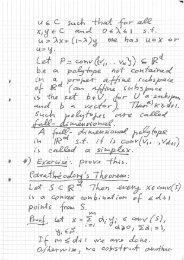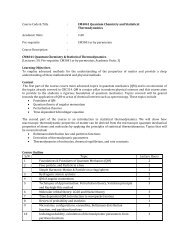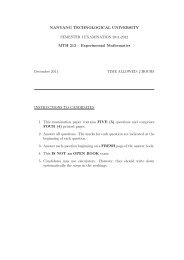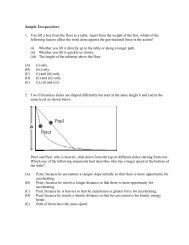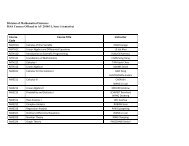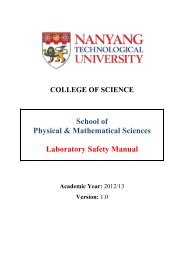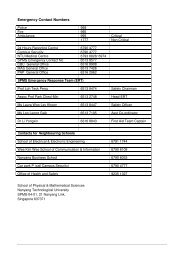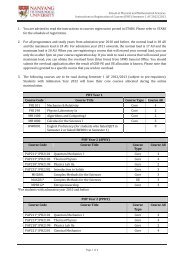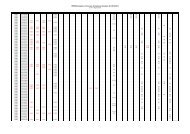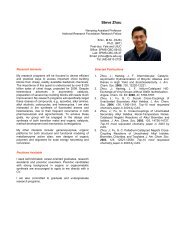1530 IEEE TRANSACTIONS ON INFORMATION THEORY, VOL. 59, NO. 3, MARCH 2013(<strong>for</strong> example, by taking an extended RS code). Due to Corollary8.12, this static ECIC is optimal.Remark 8.14: We observe from the proof of Theorem 8.11that the problem of constructing an optimal linear (non-errorcorrecting)index code, which is static under , is, in fact,equivalent to the problem of constructing a parity check matrixof a classical linear error-correcting code.Example 8.15: Let , , ,and .From[21], the smallest possible dimension of a binary linear code oflength 20 and minimum distance 11 is 3. We obtain that.Wealsohave. Theorem 8.11 implies theexistence of a one-error-correcting binary index code of length22 which can be used <strong>for</strong> any instance of IC problem, in whicheach receiver owns at least 10 out of (at most) 20 messages, asside in<strong>for</strong>mation. It also implies that the length of any such staticECIC is at least. Corollary 8.12 provides a betterlower bound on the minimum length, which is .Example 8.16: Below we show that with the same number ofinputs and outputs , a weakly resilient function may havestrictly higher resiliency .From Example 8.15, there exists a linear vectorial Booleanfunctionwhich is 10-weakly 2-resilient.According to [21], an optimal linear code has minimumdistance . Hence, due to Theorem 8.6, the resiliencyof any linear vectorial Boolean functioncannot exceed one.The problem of constructing an matrix that satisfiesthe -Property is a natural generalization of the problem ofconstructing the parity check matrix of a linearcode. Indeed, is a parity check matrix of ancode if and only if every set of columns of is linearlyindependent. Equivalently, any nontrivial linear combination ofat most columns of has weight at least one. For comparison,satisfies the -Property if and only if any nontrivial linearcombination of at most columns of has weight at least.Some classical methods <strong>for</strong> deriving bounds on the parametersof error-correcting codes can be generalized to the caseof linear static ECICs. Below we present a Gilbert–Varshamovlikebound.Theorem 8.17: Let denotes the volume of -arysphere of radius in given by (12). Ifthen there exists an matrix which satisfies the-Property.Proof: We build up the set of rows of one by one.The first row can be any vector in of weight at least .Nowsupposewehavechosen rows so that no nontrivial linearcombination of at most among these rows have weight lessthan . There are at mostvectors which are at distance less than from any linearcombination of at most among chosen rows (this includesvectors at distance less than from ). If this quantity issmaller than , then we can add another row to the set sothat no nontrivial linear combination of at most rows in hasweight less than . The claim follows if we replace by.Remark 8.18: If we apply Theorem 6.1 to the instancedefined in the beginning of this section, thenwe obtain a bound, which is somewhat weaker then its counterpartin Theorem 8.17, namely the matrix as aboveexists ifIX. CONCLUSIONIn this work, we generalize the <strong>Index</strong> <strong>Coding</strong> with <strong>Side</strong> In<strong>for</strong>mationproblem toward a setup with errors. Under this setup,each receiver should be able to recover its desired message evenif a certain amount of errors happen in the transmitted data. Thisis the first work that considers such a problem.A number of bounds on the length of an optimal error-correctingindex code are constructed. As it is shown in Example4.8, a separation of error-correcting code and index code sometimesleads to a nonoptimal scheme. This raises a question ofdesigning coding schemes in which the two layers are treatedas a whole. There<strong>for</strong>e, the question of constructing error-correctingindex codes with good parameters is still open.A general decoding procedure <strong>for</strong> linear error-correctingindex codes is discussed. The difference between decoding ofa classical error-correcting code and decoding of an error-correctingindex code is that in the latter case, each receiver doesnot require a complete knowledge of the error vector. Thisdifference may help to ease the decoding process. Finding anefficient decoding method <strong>for</strong> error-correcting index codes(together with their corresponding constructions) is also still anopen problem.The notion of error-correcting index code is further generalizedto static index code. The latter is designed to serve afamily of instances of error-correcting index coding problem.The problem of designing an optimal static error-correctingindex code is studied, and several bounds on the length of suchcodes are presented.APPENDIXLemma A.1: If is symmetric, then the generalized independencenumber of is the independence number of .Proof: It suffices to show that if is symmetric, then theset of generalized independent sets of and the set of independentsets of coincide.Let be a generalized independent set in .If ,thenobviously is an independent set in . Assume that .For any pair of vertices ,theset belongs to .By definition of , either there is no edge from to ,orthereisnoedgefrom to ,in .Since is symmetric, there
DAU et al.: ERROR CORRECTION FOR INDEX CODING WITH SIDE INFORMATION 1531are no edges between and , in neither directions. There<strong>for</strong>e,is an independent set in .Conversely, let be an independent set in . For each, since there are no edges from to all other vertices in ,wededuce that . Due to (3), every subset of whichcontains belongs to . This holds <strong>for</strong> an arbitrary .There<strong>for</strong>e, every nonempty subset of belong to .Weobtain that is a generalized independent set of .ACKNOWLEDGMENTThe authors would like to thank the authors of [7] <strong>for</strong> providinga preprint of their paper.REFERENCES[1] Y. Birk and T. Kol, “In<strong>for</strong>med-source coding-on-demand (ISCOD)over broadcast channels,” in Proc. IEEE Conf. Comput. Commun.,SanFrancisco, CA, 1998, pp. 1257–1264.[2] Y. Birk and T. Kol, “<strong>Coding</strong>-on-demand by an in<strong>for</strong>med source(ISCOD) <strong>for</strong> efficient broadcast of different supplemental datato caching clients,” IEEE Trans. Inf. Theory, vol. 52, no. 6, pp.2825–2830, Jun. 2006.[3] S. E. Rouayheb, A. Sprintson, and C. Georghiades, “On the indexcoding problem and its relation to network coding and matroid theory,”IEEE Trans. Inf. Theory, vol.56,no.7,pp. 3187–3195, Jul. 2010.[4] S.Katti,H.Rahul,W.Hu,D.Katabi,M.Médard, and J. Crowcroft,“XORs in the air: Practical wireless network coding,” in Proc. ACMSIGCOMM, 2006, pp. 243–254.[5] S. Katti, D. Katabi, H. Balakrishnan, and M. Médard, “Symbol-levelnetwork coding <strong>for</strong> wireless mesh networks,” ACM SIGCOMMComput. Commun. Rev., vol. 38, no. 4, pp. 401–412, 2008.[6] Z. Bar-Yossef, Z. Birk, T. S. Jayram, andT.Kol,“<strong>Index</strong>codingwithside in<strong>for</strong>mation,” in Proc. 47th Annu. IEEE Symp. Found. Comput.Sci., 2006, pp. 197–206.[7]Z.Bar-Yossef,Z.Birk,T.S.Jayram,and T. Kol, “<strong>Index</strong> codingwith side in<strong>for</strong>mation,” IEEE Trans. Inf. Theory, vol. 57, no. 3, pp.1479–1494, Mar. 2011.[8] E. Lubetzky and U. Stav, “Non-linear index coding outper<strong>for</strong>ming thelinear optimum,” in Proc.48thAnnu. IEEE Symp. Found. Comput. Sci.,2007, pp. 161–168.[9] Y. Wu, J. Padhye, R. Chandra, V. Padmanabhan, and P. A. Chou, “Thelocal mixing problem,” presented at the presented at the Inf. TheoryAppl. Workshop, San Diego, CA, 2006.[10] S. E. Rouayheb, M. A. R. Chaudhry, andA.Sprintson,“Ontheminimum number of transmissions in single-hop wireless codingnetworks,” in Proc. IEEE Inf. Theory Workshop, 2007, pp. 120–125.[11] S. E. Rouayheb, A. Sprintson, and C. Georghiades, “On the relationbetween the index coding and the network coding problems,” in Proc.IEEE Symp. Inf. Theory, Toronto, ON, Canada, 2008, pp. 1823–1827.[12] M. A. R. Chaudhry and A. Sprintson, “Efficient algorithms <strong>for</strong> indexcoding,” in Proc. IEEE Conf. Comput. Commun., 2008, pp. 1–4.[13] N. Alon, A. Hassidim, E. Lubetzky, U. Stav, and A. Weinstein, “Broadcastingwith side in<strong>for</strong>mation,” in Proc. 49th Annu. IEEE Symp. Found.Comput. Sci., 2008, pp. 823–832.[14] R.Ahlswede,N.Cai,S.Y.R.Li, and R. W. Yeung, “Network in<strong>for</strong>mationflow,” IEEE Trans. Inf. Theory, vol. 46, no. 4, pp. 1204–1216,Jul. 2000.[15] R. Koetter and M. Médard, “An algebraic approach to network coding,”IEEE/ACM Trans. Netw., vol. 11, no. 5, pp. 782–795, Oct. 2003.[16] W. Haemers, “An upper bound <strong>for</strong> the Shannon capacity of a graph,”Algebr. Methods Graph Theory, vol. 25, pp. 267–272, 1978.[17] R. Peeters, “Orthogonal representations over finite fields and the chromaticnumber of graphs,” Combinatorica, vol. 16, no. 3, pp. 417–431,1996.[18] R. Peeters, “Uniqueness of strongly regular graphs having minimal-rank,” Linear Algebra Applicat., vol. 226–228, pp. 9–31, 1995.[19] R. Peeters, “On the -ranks of net graphs,” Designs, Codes Cryptogr.,vol. 5, pp. 139–153, 1995.[20] S. H. Dau, V. Skachek, and Y. M. Chee, “On the security of indexcoding with side in<strong>for</strong>mation,” IEEE Trans. Inf. Theory,vol.58,no.6,pp. 3975–3988, Jun. 2012.[21] M. Grassl, Bounds on the Minimum Distance of Linear Codes andQuantum Codes [Online]. Available: http://www.codetables.de[22] M. Chudnovsky, N. Robertson, P. Seymour, and R. Thomas, “Thestrong perfect graph theorem,” Ann. Math., vol. 164, pp. 51–229,2006.[23] E. R. Berlekamp, R. J. McEliece, and H. C. A. van Tilborg, “On theinherent intractability of certain coding problems,” IEEE Trans. Inf.Theory, vol. IT-24, no. 3, pp. 384–386, May 1978.[24] B. Chor, O. Goldreich, J. Håstad, J. Freidmann, S. Rudich, and R.Smolensky, “The bit extraction problem or t-resilient functions,” inProc. 26th Annu. IEEE Symp. Found. Comput. Sci., 1985, pp. 396–407.[25] C. H. Bennet, G. Brassard, and J. M. Robert, “Privacy amplification bypublic discussion,” SIAM J. Comput., vol. 17, pp. 210–229, 1988.[26] C. Carlet, Vectorial Boolean Functions <strong>for</strong> Cryptography, ser.(ser.Boolean Models and Methods in Mathematics, Computer Science andEngineering). Cambridge, U.K.: Cambridge Univ. Press, 2010, ch. 9.[27] X.-M. Zhang and Y. Zheng, “On nonlinear resilient functions,” inProc. 14th Annu. Int. Conf. Theory Appl. Cryptogr. Technol., 1995,pp. 274–288.[28] K. Gupta and P. Sarkar, “Improved construction of nonlinear resilients-boxes,” IEEE Trans. Inf. Theory, vol. 51, no. 1, pp. 339–348, Jan.2005.[29] F. J. MacWilliams and N. J. A. Sloane, The Theory of <strong>Error</strong>-CorrectingCodes. Amsterdam, The Netherlands: North Holland, 1977.Son Hoang Dau received the B.S. degree in applied mathematics and in<strong>for</strong>maticsfrom the College of Science, Vietnam National University, Hanoi,Vietnam, in 2006. He received the M.S. degree (2009) and Ph.D. degree(2012) in mathematical sciences from the Division of Mathematical Sciences,Nanyang Technological University, Singapore.During 2011-2012, he held research positions with Nanyang TechnologicalUniversity. He is currently a research fellow at SUTD-MIT International DesignCentre, Singapore University of Technology and Design, Singapore.His research interests are coding theory, network coding, and combinatorics.Vitaly Skachek received the B.A. (Cum Laude), M.Sc. and Ph.D. degrees incomputer science from the Technion—Israel Institute of Technology, in 1994,1998 and 2007, respectively.In the summer of 2004, he visited the Mathematics of Communications Departmentat Bell Laboratories under the DIMACS Special Focus Program inComputational In<strong>for</strong>mation Theory and <strong>Coding</strong>. During 2007-2012, he held researchpositions with the Claude Shannon Institute, University College Dublin,with the School of Physical and Mathematical Sciences, Nanyang TechnologicalUniversity, Singapore, with the Coordinated Science Laboratory, University ofIllinois at Urbana-Champaign, Urbana, and with the Department of Electricaland Computer Engineering, McGill University, Montreal. He is now a SeniorLecturer with the Institute of Computer Science, University of Tartu.Dr. Skachek is a recipient of the Permanent Excellent Faculty Instructoraward, given by Technion.Yeow Meng Chee (SM’08) received the B.Math. degree in computer scienceand combinatorics and optimization and the M.Math. and Ph.D. degrees in computerscience from the University of Waterloo, Waterloo, ON, Canada, in 1988,1989, and 1996, respectively.Currently, he is an Associate Professor at the Division of Mathematical Sciences,School of Physical and Mathematical Sciences, Nanyang TechnologicalUniversity, Singapore. Prior to this, he was Program Director of Interactive DigitalMedia R&D in the Media Development Authority of Singapore, PostdoctoralFellow at the University of Waterloo and IBM’s Zürich Research Laboratory,General Manager of the Singapore Computer Emergency Response Team,and Deputy Director of Strategic Programs at the Infocomm Development Authority,Singapore.His research interest lies in the interplay between combinatorics and computerscience/engineering, particularly combinatorial design theory, coding theory,extremal set systems, and electronic design automation.



